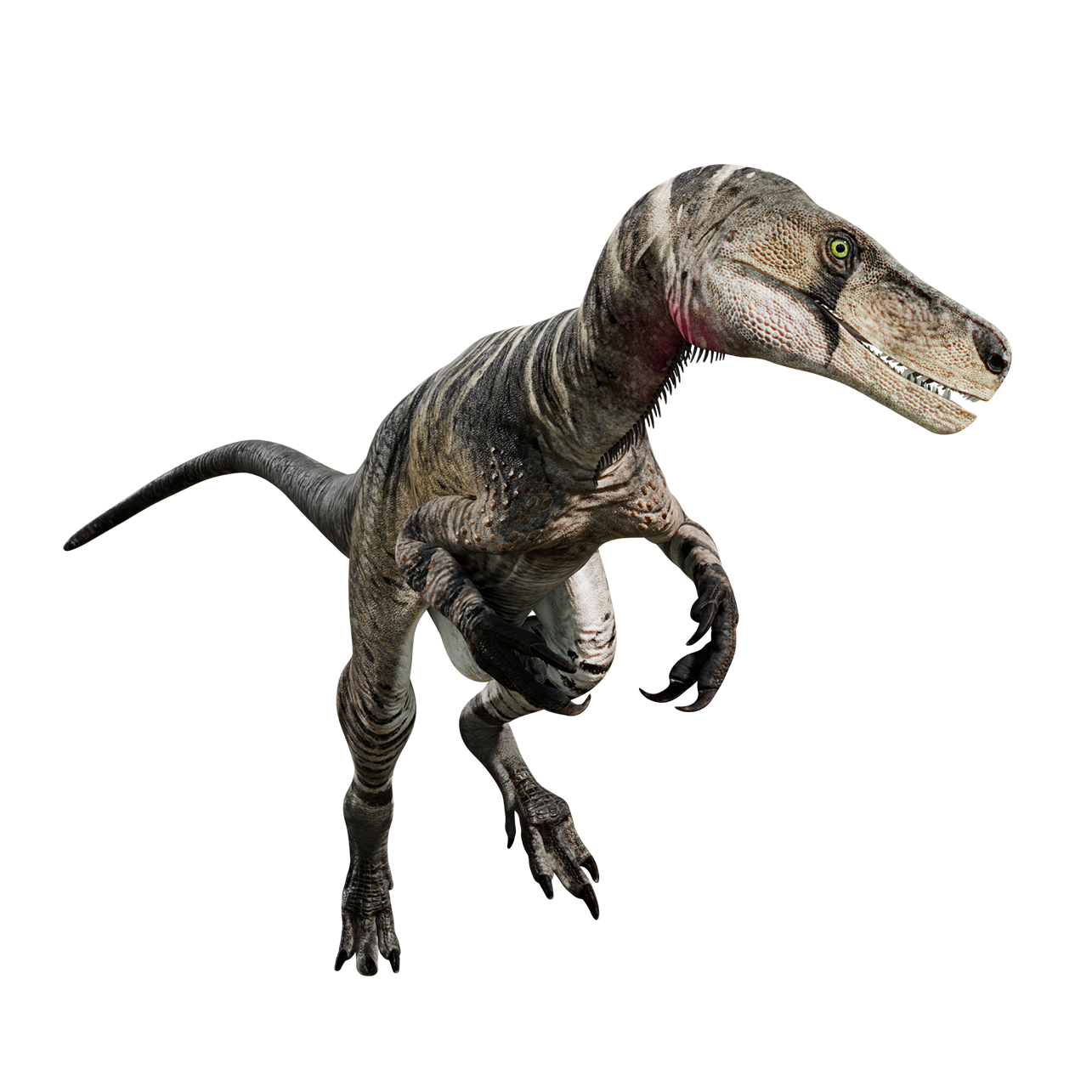A Harbinger of Dinosaur Supremacy
While most dinosaurs 131 million years ago were small, this Argentine predator grew up to 6 m long, making it the first truly large carnivorous dinosaur, and a harbinger of the dinosaur supremacy that was to come.
Overview: 231 million years ago, most dinosaurs were small and lived in the shadow of larger and more common creatures such as the dicynodonts (strange herbivorous relatives of mammals) and pseudosuchians (the group of archosaurian reptiles that includes crocodilians). There was little hint of the greatness and dominance dinosaurs would one day achieve. But in the forests of Argentina lived a shadow of what was to come. Herrerasaurus, discovered in the mid-20th century, grew up to 6 m (20 ft) in length, making it the first truly large carnivorous dinosaur. It is still debated whether it is a true theropod or a basal saurischian, but in any case, it was an important step for the dinosaurs, out of the shadows and into the role of a major predator. While still dwarfed by later theropods like T-rex, Herrerasaurus was the ecological forerunner of those later theropods, the first dinosaur to become a large predator, thus signaling the dawn of dinosaur supremacy. However, Herrerasaurus was not alone at the top of the food chain. The giant pseudosuchian Saurosuchus was slightly longer than Herrerasaurus and much heavier. Though Herrerasaurus could be considered an apex predator, it would have had to yield its dominance whenever Saurosuchus was around.
Discovery: Herrerasaurus ischigualastensis was discovered in the Ischigualasto Formation near San Juan, Argentina, by an Andean goatherd named Victorino Herrera, and described in 1963 by Osvaldo Reig. The dinosaur was named after Herrera, with a name meaning “Herrera’s Lizard” (Herrera + Greek sauros, meaning lizard). The species name means “from Ischigualasto”. The holotype remains of Herrerasaurus (PVL 2566) were fragmentary, but additional material, including a partial skeleton called Ischisaurus, two partial skeletons called Frenguellisaurus, and a complete skull discovered in 1988 (PVSJ 407) and referred to Herrerasaurus have cast additional light on Herrerasaurus (Ischisaurus and Frenguellisaurus were synonymized with Herrerasaurus in 1992).
Evolution: Herrerasaurus was one of the earliest known dinosaurs and a member of the family Herrerasauridae, which also included fellow Ischgualasto resident Sanjuansaurus and the slightly older Brazilian Staurikosaurus. Herrasaurids are probably the earliest branch of the theropods, though they are also sometimes found to be basal saurischians, related to both theropods and sauropodomorphs, and rarely, some analyses have found them to actually not be dinosaurs at all, though most studies find them to indeed be dinosaurs. Due to the fragmentary nature of many herrerasaurids and other early dinosaurs, and the incompleteness of the fossil record pertaining to the first dinosaurs, it can be difficult to determine the relationships between some of them and the much of our understanding of the origin of dinosaurs is still shrouded in mystery.
Description: Herrerasaurus had a basic theropod body plan. It was bipedal, digitigrade (it walked on its toes), and had a long tail. Its hands had five fingers, the outer two being reduced and the middle three bearing sharp grasping claws. Its arms were rather short, but it had relatively long hands. It had powerful legs, with a proportionally long tibia (shin) and metatarsus (middle foot bones), indicating a swift runner. The jaws of Herrerasaurus were lined with the large sharp serrated teeth of a predator. The classification of Herrerasaurus and its kin is made difficult by their unusual mix of primitive and advanced traits. The skull is long and low and, in many ways, resembles non-dinosaurian archosaurs such as Euparkeria more than other theropods. Additionally, the acetabulum (hip socket) is only partially open, whereas most dinosaurs have an entirely open acetabulum, and the hips are only supported by two sacral vertebrae, while most dinosaurs had more sacral vertebrae. However, the pubis resembles that of more advanced theropods and is pointed backwards like in dromaeosaurs and birds, and the vertebrae are shaped like those of Allosaurus. Finally, Herrerasaurus had a uniquely flexible joint in the lower jaw that could slide back and forth to deliver a grasping bite, a trait absent in other dinosaurs and their relatives, but present in some lizards. Herrerasaurus was the largest dinosaur of its ecosystem, and the first truly large carnivorous dinosaur, measuring 6 m (20 ft) in length and weighing about 350 kg (770 lb). Like other dinosaurs it was probably warm-blooded and may have been feathered, though feathers aren’t directly known from Herrerasaurus. Altogether, the strange combination of traits in Herrerasaurus seems almost poetic, paying tribute to more basal archosaurs with its more primitive traits while foreshadowing the theropods’ grand future with its large size and more advanced traits.
Ecology: Herrerasaurus was found in the Ischigualasto Formation which represents a rich floodplain environment with abundant plants, including ferns, horsetails, and cycads, and towering above them, relatives of ginkgoes, monkey puzzles, and redwoods. The climate was lush enough to support these plants, but rain was highly seasonal, and there was probably a distinct wet and dry season. Large herbivores included the dicynodonts Ischigualastia and Jachaleria, the herbivorous cyndont Exaeretodon, and the aetosaur (an armored herbivorous relative of crocodiles) Aetosauroides. Small herbivores and omnivores would have included rhynchosaurs, the primitive sauropodomorph Panphagia, and the enigmatic dinosaur-like silesaurids. Small predators included cynodonts, the early crocodylomorph, Trialestes, and the early theropod Eodromeus and the primitive sauropodomorph Eoraptor. All these animals could have been on the menu for Herrerasaurus, though it probably would have lacked the power to take down the large herbivores, perhaps instead preying on their young. Herrerasaurus also lived alongside the fellow herrerasaurid Sanjuansaurus, which was around half the length of an adult Herrerasaurus, likely filling the role of mesopredator and potentially competing with Herrerasaurus for small vertebrate prey items like cynodonts, rhynchosaurs, or silesaurs. Herrerasaurus was the most common predator of the Ischigualasto, but there was still one creature which it would have feared, the giant pseudosuchian Saurosuchus, a terrestrial relative of crocodiles. While Herrerasaurus could be considered an apex predator, THE apex predator was Saurosuchus, which would have probably been both a predator and a competitor of Herrerasaurus. Healed bite marks in a Herrerasaurus skull may have been dealt by Saurosuchus, or possibly another Herrerasaurus. Near waterways, young Herrerasaurus also would have had to be wary of semiaquatic predators like the large temnospondyl amphibians Promastodonsaurus and Pelorocephalus and the crocodile-like proterochampsid reptile Proterochampsa.
Extinction: Herrerasaurus was highly successful in the Ischigualasto Formation, and the herrerasaurids were the top dinosaurian predators in many early Late Triassic ecosystems. However, their supremacy would not last. As dinosaurs continued to diversify and adapt to the changing conditions of the late Triassic, the Herrerasaurs were replaced by newer theropods, specifically, the highly successful and adaptable Coelophysoids. Herrerasaurus skeletal mounts can be seen in various museums including the Museum of Ancient Life at Thanksgiving Point in Lehi, UT, USA, the Field Museum of Natural History in Chicago, IL, USA, the Carnegie Museum of Natural History in Pittsburgh, PA, USA, and the Royal Ontario Museum in Toronto, Ontario, Canada.
Herrerasaurus FAQ
Herrerasaurus size / How big was Herrerasaurus?
See height, weight, and length.
Herrerasaurus height / How tall was Herrerasaurus?
Herrerasaurus was around 2 meters (6.56 ft) tall.
Herrerasaurus weight / How much did Herrerasaurus weigh?
Herrerasaurus probably weighed about 350 kg (772 lb).
How long was Herrerasaurus?
Herrerasaurus grew 6 m (20 ft) in length.
What did Herrerasaurus eat?
Herrerasaurus ate meat, probably other dinosaurs as well as other herbivores, including cynodonts, rhynchosaurs, silesaurs, and dicynodonts.
What is Herrerasaurus’s closest living relative?
Like all dinosaurs, the closest relatives of Herrerasaurus are the only surviving lineage of dinosaurs today, the birds. Crocodilians, while not dinosaurs themselves, are also more distant cousins of dinosaurs.
Herrerasaurus family members / Herrerasaurus family / What kind of dinosaur was Herrerasaurus?
Herrerasaurus was a member of the family Herrasauridae, a clade of early saurischian dinosaurs which resembled theropods (two-legged, mainly carnivorous dinosaurs) and were probably early theropods themselves. They were among the first medium-large-sized carnivorous dinosaurs to evolve.
Where did Herrerasaurus live? / Where was Herrerasaurus found?
Herrerasaurus lived in what is now Argentina.
When did Herrerasaurus live?
Herrerasauruslived about 231-228 million years ago during the Late Triassic Period.
What does Herrerasaurus mean? / Herrerasaurus name meaning
Herrerasaurus means “Herrera’s Lizard” in honor of its discoverer Victorino Herrera.

